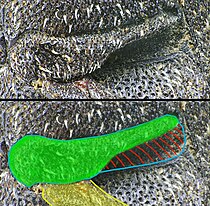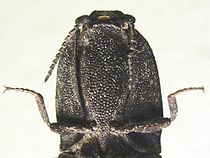White-scaled click beetle
| White-scaled click beetle | ||||||||||||
|---|---|---|---|---|---|---|---|---|---|---|---|---|

White-scaled click beetle ( Lacon punctatus ) |
||||||||||||
| Systematics | ||||||||||||
|
||||||||||||
| Scientific name | ||||||||||||
| Lacon punctatus | ||||||||||||
| ( Autumn , 1779) |
The Weißschuppige beetle ( Lacon punctatus ) is a species of beetle from the family of beetles (Elateridae). The species is classified in the Red List of Threatened Species in Germany under category 0 (extinct or lost). The unusually large click beetle used to be native to Germany.
Notes on the name
The species was first described in autumn 1779 under the scientific name Elater punctatus and the German name "Weißpunctirter Springkäfer". In the detailed characterization, Herbst writes, among other things: It is thoroughly carbon black, without gloss, and very neatly sprinkled with white dots everywhere . This explains the species name punctātus ( Latin , dotted). The German name emphasizes that the white dots are caused by white scales.
The generic name Lácon is from Altgr. Λάκον Lákon derived. Schenkling comments: Laconians? For the Roman agricultural writer Columella from the 1st century AD Dog name! - According to government councilor Dr. Fuchs in Dresden the word here means as much as tramp.
The genus Lacon includes six species, all of which also occur in Europe
description
Imago
The Weißschuppige beetle different as the other kinds of the subfamily Agrypinae on the kinds of other subfamilies characterized in that the after folded down sides of the neck plate are separated by a gap of gaping of the front chest. (Prosternal furrow, Fig. 4). This gap extends almost to the front edge of the front hips and the beetle can insert its antennae completely into it. The front chest is rounded at the front (Prosternal lobe), the mouthparts can be hidden behind it. The rear end of the front chest is elongated into a long tooth that can snap into a recess in the middle chest. This enables the beetle to jump up from the supine position, which is what gave the family its name.
The genus Lacon includes species that are densely scaled on top. In the white-scaly click beetle, these scales are predominantly matt black, with individual pale white scales scattered between them that do not form a pattern. The pronotum is longer than it is wide, rounded at the front and parallel in the middle. The sides of the pronotum are completely sharply edged, and the posterior angles of the pronotum are slightly drawn out. In the middle it is shallowly deepened in the shape of a channel, raised to the side with a hump. The elytra are dense and irregularly punctured , but the puncture is covered by the scales. Longitudinal ribs are only indicated. The antennae are eleven, the second antennae small and spherical, the third to eleventh elements sawn. As with all click beetles, the legs are weakly developed with five-limbed tarsi.
The shape of the thigh covers (Fig. 5) is of systematic importance.
larva
The larva has three pairs of legs, is cylindrically elongated and brown-yellow ( wireworm ). The head and the last segment of the body are heavily sclerotized and dark brown. The last segment of the body ends in a split-pincer shape ( urogomph ) and has lateral teeth.
Occurrence
The beetle lives very hidden, especially in the Mediterranean area under the bark of deciduous and coniferous trees , where the larvae develop. He is classified as a waste wood colonist. It died out in Germany . In addition, Central Europe, the Caucasus and the Crimean Peninsula are given as distribution areas .
literature
- Heinz Joy, Karl Wilhelm Harde, Gustav Adolf Lohse: The beetles of Central Europe . tape 6 : Diversicornia . Spectrum, Heidelberg 1979, ISBN 3-87263-027-X .
- Klaus Koch : The Beetles of Central Europe Ecology . 1st edition. tape 2 . Goecke & Evers, Krefeld 1989, ISBN 3-87263-040-7 . P. 70
Individual evidence
- ↑ Red lists at BioNetworkX
- ↑ JFW Herbst: Description and illustration of some, partly new, partly not yet shown insect activities of the Berlin Society of Friends of Nature 4 Berlin 1779 First description of the species, page 316
- ↑ Sigmund Schenkling: Nomenclator coleopterologus 2nd edition Jena 1922 Explanation of the scientific beetle names (species) in short form
- ↑ Sigmund Schenkling: Nomenclator coleopterologus 2nd edition Jena 1922 Explanation of the scientific beetle names (genus) in short form
- ^ Lacon at Fauna Europaea. Retrieved March 22, 2013
- ↑ Lacon in BioLib
- ↑ a b page about Lacon punctatus, on the right you can click a picture of the larva
- ↑ Classification as reclaimed wood colonists, No. 406, according to Schmidl & Bussler 2004 ( Memento from September 27, 2007 in the Internet Archive )
Web links
- Lacon punctatus at Fauna Europaea





